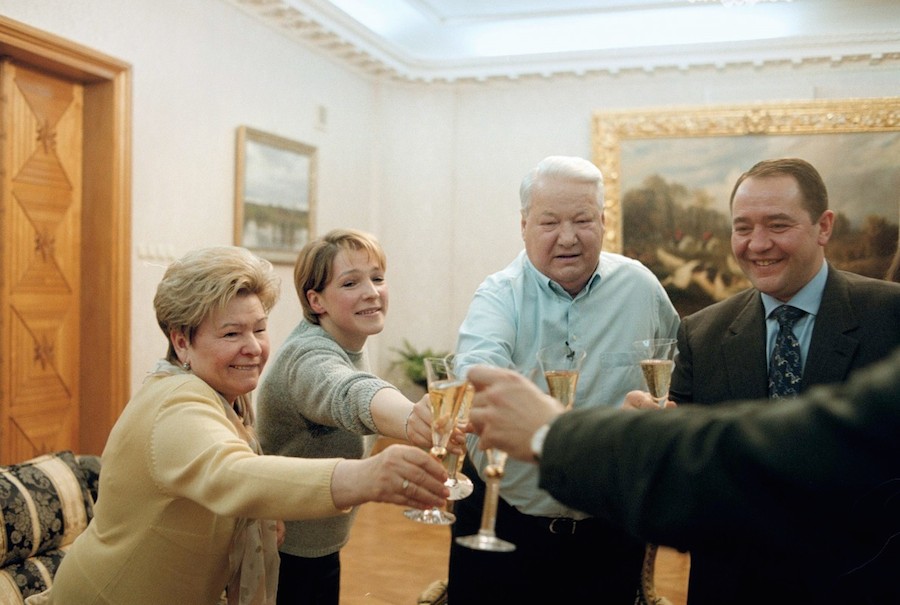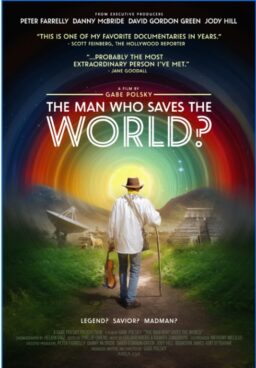There wasn’t a dry eye in the house as the visage of Miloš Forman once again radiated from the stage in the Grand Hall of Hotel Thermal, only this time, it was projected on a screen. As part of the elegant closing ceremony for the 53rd Karlovy Vary International Film Festival held on July 7th, an In Memoriam segment was screened that mixed Hollywood icons with giants of Czech cinema. Forman, who passed away on April 13th at age 86, served as a bridge between both worlds, and it was only appropriate that his segment in the montage was saved for last. The audience applauded throughout the entirety of the clip, showcasing the famous final moments of Forman’s Oscar-winning classic, “One Flew Over the Cuckoo’s Nest,” where Chief Bromden pulls off a crowd-pleasing escape. Yet the cheers morphed into an aching silence, as footage materialized of the filmmaker accepting KVIFF’s highest honor—the Crystal Globe for Outstanding Artistic Contribution to World Cinema—in the exact same theater 21 years ago. There’s no question that the presence of Forman’s spirit was palpably felt throughout the evening. Though Robert Pattinson received the most media attention while accepting the President’s Award, it was a fellow honoree, veteran Czech actor Jaromír Hanzlík, who earned the most rapturous ovation of the ceremony.
The past week has left me feeling drained and exhilarated, and I wish it could’ve gone on for at least a week longer, if only so that I could find time to see more of the winning films. The Grand Prix went to Radu Jude’s Romanian drama, “I Do Not Care If We Go Down in History as Barbarians,” a film that juror Mark Cousins hailed for “pointing a finger at the people who are rewriting history.” 33-year-old Olmo Omerzu, one of my very favorite modern Czech filmmakers, earned a richly deserved Best Director prize for his latest triumph, “Winter Flies,” which I reviewed in my second dispatch. “Sueño Florianópolis,” a family road movie from Argentinian director Ana Katz, took home a Special Jury Prize as well as the Best Actress accolade for its lead, Mercedes Moran, who ended her speech by calling for the legalization of abortion in her home country. Other big prizes of the night were given to Moshe Folkenflik, Best Actor winner for the Israeli film, “Redemption,” and Elizaveta Stishova’s Kyrgyzstani/Russian co-production, “Suleiman Mountain,” Grand Prix winner in the East of the West competition. Yet perhaps most potent of all was the recipient of the top prize in the documentary competition—a picture that is destined to galvanize American audiences as midterm elections inch ever closer on the calendar.
“Putin’s Witnesses” is the latest amazement from director Vitaly Mansky, whose penchant for keeping the camera rolling has served him remarkably well over the years. His 2015 film, “Under the Sun,” contrasts scenes crafted for propaganda purposes by the North Korean government with moments of unscripted truth. His new film has similar origins—the footage was originally captured for the purposes of Vladimir Putin’s electioneering, intensified by the sudden retirement of Russian president Boris Yeltsin on New Year’s Eve of 1999. What immediately sets Putin apart from a crude blowhard like Trump is the cool-headed, persuasive nature of his public persona. He comes across as a reasonable human being, granting Mansky and his camera jaw-dropping access, while willingly engaging in the filmmaker’s spirited debates. Yeltsin mistakenly thinks the newly elected Putin will fight against totalitarianism while ensuring the freedom of the media. Instead, as evidenced in numerous onscreen conversations, Putin intended to exploit the nostalgia of the populace by guiding it backwards through history toward a revived Soviet nationalism. A string of bombings further fuel Putin’s agenda, causing citizens to vote with their heart rather than delve too deep beneath the surface of the candidate’s promises or omissions (such as his never-addressed economic plan). It’s not long afterward that TV journalists will be censored for speaking out against Putin, while those less lucky will simply be bumped off. “Tacit concern,” as defined by Mansky, is what turns witnesses into accomplices, and the director reveals himself to be one of the most crucial witnesses of all.

Ranking high among the other gems I caught at KVIFF is Alonso Ruizpalacios’ “Museum,” a Mexican heist film that is so much more entertaining and thoughtful than I had expected it to be. It’s also a huge upgrade from the naggingly dull “Ocean’s 8,” and not just in terms of how it utilizes museum locations. Having just serenaded the world with the tear-jerking tune, “Remember Me,” in Pixar’s great and regrettably timely “Coco,” Gael García Bernal turns in another splendid performance as Juan, a determined young man who goes to extreme lengths in order to remind others about the importance of history. Inspired by a real-life burglary of epic proportions, the screenplay by Ruizpalacios and Manuel Alcalá (which earned a Silver Bear at Berlinale) is narrated by Benjamin (Leonardo Ortizigris), the friend Juan recruits to help steal priceless Mayan and Mesoamerican artifacts from the National Museum of Anthropology. Though’s Juan’s motivations occasionally seem no less empty-headed than those of the kids in “American Animals,” at one point claiming that he’s simply tired of “waiting for something to happen” in his life, his true purpose stems from the betrayal he felt at a young age from watching these precious items stolen from the land where they originated. Cinematographer Damian Garcia creates compositions worthy of Hitchcock—the actual heist sequence is hold-your-breath suspenseful—and the filmmakers continuously succeed at what Juan had always strived to do: they exceed expectations at every turn.
Guaranteed to be more polarizing with audiences is the latest dizzying spectacle from Gaspar Noé, the visionary French provocateur who routinely pushes the envelope on what viewers can withstand before fleeing from the theater. With the exception of his 2009 masterpiece, “Enter the Void,” Noé’s films are comprised of overwhelmingly visceral moments strung through a narrative that is less-than-memorable. In the case of “Climax,” perhaps the first picture in his career that is proving to somewhat of a crowd-pleaser, the first half is so deliriously enjoyable that one hopes the second half—where everything inevitably goes to hell—will never arrive. After a series of talking head interviews with young dancers, which materialize on a television screen surrounded stacks of prophetic VHS tapes (including “Suspiria” and “Labyrinth Man,” a.k.a. the original title of “Eraserhead”), the film dives headfirst into a group dance number so spectacular in its frenzied choreography and swirling camerawork (kudos again to Noé’s irreplaceable DP, Benoît Debie) that the Grand Hall erupted in applause. Think the opening sequence in “La La Land” if the lyrics had been “Another Day of Drugs.” Yet once the sangria at this all-night dance party becomes spiked with LSD, the film becomes considerably less interesting, as the kids stumble through a murky labyrinth while tearing each other apart. Still, Noé never reaches the explicit levels of sex and violence that defined his earlier pictures, thus making this one his most accessible to date.
If any intriguing line could be drawn between “Climax” and “Cold War,” the latest black-and-white marvel from Polish master Pawel Pawlikowski, it is the frequent insertion of black frames throughout the narrative. Whereas Noé uses a black screen to separate shots that are meant to resemble seamless blocks of unbroken time, Pawlikowski cuts to black whenever his narrative skips over a chasm of time in order to arrive at the next pivotal moment in the torrid romance between a musician, Wiktor (Tomasz Kot), and a singer, Zula (Joanna Kulig). In a tale that spans fifteen years and multiple countries, Pawlikowski beautifully illustrates how, as one character observes, time doesn’t matter when one is in love. When this pair gets together, it’s as if the years they spent apart have faded into the ether. Zula is a fascinating character prone to making bold decisions, including one that has proven to define her life. When prodded on why she nearly killed her father, Zula explains, “He mistook me for my mother, and I used a knife to show him the difference.” Though “Cold War” doesn’t quite have the emotional impact of Pawlikowski’s 2014 Oscar winner, “Ida,” it is every bit as exquisite a showcase for cinematographer Lukasz Zal, filling the 4:3 aspect ratio with a painterly level of detail, culminating with an impeccably timed gust of wind. Yet my favorite scene of all is when Zula dances at a bar to “Rock Around the Clock,” prompting the woman seated next to me to start dancing in her seat. Only a few evenings beforehand, I was at the same venue—the gorgeous Neo-Baroque Municipal Theatre—watching Tim Robbins and The Rogues Gallery Band bring down the house with a two-and-a-half hour Fourth of July concert. Their final song was “Hang On Sloopy,” another golden oldie that brought the entire theater to their feet singing. It was a euphoric experience that easily topped any fireworks display I’ve attended.
Last but not least, I must share a few highlights from this past weekend’s press conference with Barry Levinson, another of this year’s Crystal Globe honorees. The film for which he earned the Academy Award for Best Director, 1988’s “Rain Man,” became the surprise winner of KVIFF’s Právo audience award, thanks to its thirtieth anniversary screening at the festival. Of course, before I knew Levinson as an accomplished director, I knew him as the deranged bellhop who stabbed Mel Brooks in the shower with a rolled-up newspaper in 1977’s uproarious Hitchcock parody, “High Anxiety.” I couldn’t resist asking Levinson about this scene, and he was only too happy to discuss it.
“I was one of three writers who worked with Mel Brooks on the film, and we would throw ideas around,” Levinson told me. “Sometimes they worked, sometimes they didn’t. At one point, I started talking about Bernard Herrmann’s music for the shower scene in ‘Psycho’—‘EEE! EEE! EEE!’ I started putting lines to it and went, ‘HERE! HERE! HERE!’ The idea simply came from me imitating the music. And Mel said, ‘That’s so insane—if we do that, you’ve got to play the bellhop.’ That is how that scene came about. Not long ago, I was going through security on my way to Los Angeles, and I was just about to step through before realizing that I had my key in my pocket. I got my key and put it on the conveyer belt, but the agent said that I could come through with it. I said, ‘But my key is metal and it’ll beep,’ and he said, ‘No, just come through.’ So I stepped through, it beeps, and he immediately said, ‘Get into the machine.’ He told me where to put my feet for the full-body scan, and then he leans in and says, ‘I loved you in ‘High Anxiety.’ Hands up over your head!’”
Levinson’s latest film, “Paterno,” which premiered on HBO in April, also screened at KVIFF, and stars Al Pacino as the celebrated college football coach whose life and reputation are forever tarnished by the repercussions of denial. The sex scandals that have shaken the foundations of Hollywood and Michigan State University are reflected in the self-serving steps that enabled Jerry Sandusky to abuse students at Penn State.
“Paterno became the winningest coach in the history of college football on a Saturday afternoon,” said Levinson. “Eight days later, the scandal broke. Immediately, he’s under pressure and finds himself fired. Then he learns that he has cancer and will die within months. That happens within a two-week period, and it seemed like an interesting place to start the film. I thought the film should open with him getting into an MRI machine, so basically the whole movie is a remembrance of what occurred beforehand. An MRI machine scans your body layer by layer by layer, and in the film, it is sort of scanning his life layer by layer by layer. While he is in that MRI machine, all of these things that have happened in that time frame are flashing through his head. That became our visual approach.”
Set to premiere on HBO this week is “Robin Williams: Come Inside My Mind,” a documentary about the comedy icon who received his first Oscar-nomination for Levinson’s 1987 classic, “Good Morning, Vietnam.” Levinson’s press conference reached its emotional peak at the very end, as the filmmaker paid tribute to Williams.
“He was an extraordinary character who was always filled with a certain degree of insecurities,” said Levinson. “At the time we were going to do ‘Good Morning, Vietnam,’ he had done three or four films, and none of them had been successful, so he felt the pressure that this may be his last chance. My feeling was that he was astoundingly funny and interested in everything. That aspect played out and was very influential in ‘Good Morning.’ We were shooting with the Vietnamese in a classroom, and Robin was the teacher. We did the scene and I didn’t think it worked particularly well. It didn’t feel real. The Vietnamese couldn’t do the lines that were written and it didn’t fit together right in my ear. So during the break, I’m wondering what in the world I have to do because I can’t make the Vietnamese real people. There had never been a movie at that time and I’m not sure there’s been one since that just dealt with the Vietnamese people. We only saw them during wartime, running around in the jungle. But these are people who do normal things—they eat, they go to school, they go out in the evening, they go to the movies and they have a life as people. The scene I had written did not feel real to me.”
“I was wandering around outside of the building, and I see Robin talking to the Vietnamese. They were all laughing together. The Vietnamese would say something, and then Robin would try to say something back, and he’d get a laugh. The genius of Robin was that he could communicate with people, even when they didn’t quite understand what he was saying. I watched him with the Vietnamese, and I thought, ‘This is real. Why don’t we put that in the movie?’ When we were going back to film, I said to Robin, ‘Let’s forget about all the dialogue because it’s never going to work that way. Let’s just take the plot points—what’s important in this scene—and then just start talking to them like you were talking to them over there. Let’s just start to communicate with them, and you can guide them toward some of the lines that are necessary. I’m not even going to slate it. I’ll give hand cues to the cameras, the cameras will roll and we’ll just do it that way. They will never know that we are even filming.’”
“So for all of the scenes with the Vietnamese, not only in the classroom, but wherever we went, that is the way we did it. The Vietnamese never knew what was being filmed at any given time, and when we did the softball game at the end, I didn’t even tell the Vietnamese how to play the game. When you watch the movie, you’ll notice that there are two MPs who I told, ‘If you see that they are doing something wrong, like running to the wrong base, just go over and tell them that they gotta go here, like a traffic cop. Just tell them where to go. The confusion of not knowing how to play the game will be part of it, and it will be more fun than just playing the game.’ All of those scenes really gave us a chance to understand the people, and I think that was the key to the movie. It is also what defines Robin Williams. He wanted to understand people, and knew how to connect with them.”












